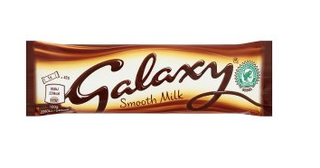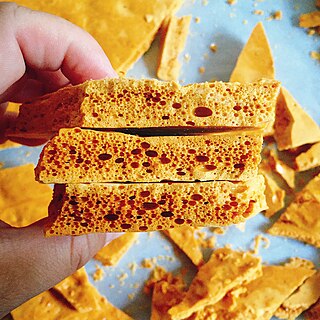
Confectionery is the art of making confections, which are food items that are rich in sugar and carbohydrates. Exact definitions are difficult. In general, however, confectionery is divided into two broad and somewhat overlapping categories: bakers' confections and sugar confections. The occupation of confectioner encompasses the categories of cooking performed by both the French patissier and the confiseur.

Cadbury, formerly Cadbury's and Cadbury Schweppes, is a British multinational confectionery company owned by Mondelez International since 2010. It is the second-largest confectionery brand in the world, after Mars. Cadbury is internationally headquartered in Greater London, and operates in more than 50 countries worldwide. It is known for its Dairy Milk chocolate, the Creme Egg and Roses selection box, and many other confectionery products. One of the best-known British brands, in 2013 The Daily Telegraph named Cadbury among Britain's most successful exports.

Caramilk is a brand name used for two distinct chocolate bar products made by Cadbury. Both were introduced in 1968. The Canadian version of Caramilk is a milk chocolate bar filled with caramel. In Australia the Caramilk brand is used for a caramel-flavoured white chocolate bar.

Freddo is a chocolate bar brand shaped like an anthropomorphic cartoon frog. It was originally manufactured by the now defunct company MacRobertson's, an Australian confectionery company, but is now produced by Cadbury. Some of the more popular flavours include strawberry and peppermint while the more controversial flavours like fruit and nut have struggled over the years.

The Heath bar is a candy bar made of toffee, almonds, and milk chocolate, first manufactured by the Heath Brothers Confectionery in 1928. The Heath bar has been manufactured and distributed by Hershey since its acquisition of the Leaf International North American confectionery operations late in 1996.
Violet Crumble is an Australian chocolate bar. The bar is a crumbly honeycomb toffee centre coated in a layer of compound chocolate. It was first made by Hoadley's Chocolates in South Melbourne around the year 1913; and is currently made in Adelaide, South Australia by Robern Menz after a period of ownership by Nestlé. Its advertising slogan is "It's the way it shatters that matters", and previously was "Nothing else matters". The bar shares similarities to the Crunchie bar made by British firm Cadbury. Aside from Australia, it is available in Hawaii and a few other places, including Hong Kong, and Mollie Stone's Markets and Cost Plus World Market in the United States.

Galaxy is a chocolate bar, made and marketed by Mars Inc., and first manufactured in the United Kingdom in the 1960s. Galaxy is sold in the United Kingdom, Ireland, South Africa, the Middle East, Morocco, India, Pakistan, Malta, and is also sold in the United States, Canada, Mexico and various Continental European countries as Dove. In 2014, Galaxy was ranked the second-best-selling chocolate bar in the UK, after Cadbury Dairy Milk.

Aero is an aerated chocolate bar manufactured by the Vevey-based company Nestlé. Originally produced by Rowntree's, Aero bars were introduced in 1935 to the North of England as the "new chocolate". By the end of that year, it had proved sufficiently popular with consumers that sales were extended throughout the United Kingdom.

Honeycomb toffee, honeycomb candy, sponge toffee, cinder toffee, seafoam, or hokey pokey is a sugary toffee with a light, rigid, sponge-like texture. Its main ingredients are typically brown sugar and baking soda, sometimes with an acid such as vinegar. The baking soda and acid react to form carbon dioxide which is trapped in the highly viscous mixture. When acid is not used, thermal decomposition of the baking soda releases carbon dioxide. The sponge-like structure is formed while the sugar is liquid, then the toffee sets hard. The candy goes by a variety of names and regional variants.
Mr. Big is the largest sized chocolate bar produced by Cadbury in Canada, hence the name. The standard bar is made of a layered vanilla wafer biscuit coated in caramel, peanuts, and rice crisps and covered in a chocolate coating. The bar is the length of two "standard"-sized bars – around 20 centimetres long. Additional varieties include Mr. Chew Big, Mr. Big Fudge, and Mr. Big with Maple.

Quality Street is a line of tinned and boxed toffees, chocolates and sweets, first manufactured in 1936 by Mackintosh's in Halifax, West Yorkshire, England. It was named after J. M. Barrie's play Quality Street. Since 1988, the confectionery has been produced by Nestlé. Quality Street has long been a competitor to Cadbury Roses, which were launched by Cadbury in 1938. Nestlé does not distribute Quality Street in the US, but it may be ordered online for delivery, or found in specialty candy shops.

Bertie Beetle is a small chocolate bar manufactured by Nestlé. It consists of a chocolate coated bar containing small pieces of honeycomb that is shaped like an anthropomorphised beetle. It was originally created as a way to use up honeycomb left over from the production of Violet Crumble bars. Originally manufactured in Australia, today they are manufactured in a factory in New Zealand.

Cadbury Roses is a brand of chocolates made by Cadbury. Introduced in the UK in 1938, they were named after the English packaging equipment company "Rose Brothers" based in Gainsborough, Lincolnshire, that manufactured and supplied the machines that wrapped the chocolates.
Mackintosh's Toffee is a sweet created by Mackintosh Company.

Fry's Turkish Delight is a chocolate bar made by Cadbury. It was launched in the UK in 1914 by the Bristol-based chocolate manufacturer J. S. Fry & Sons and consists of a rose-flavoured Turkish delight surrounded by milk chocolate. The Fry's identity remained in use after Fry & Sons merged with Cadbury in 1919.
Curly Wurly is a brand of chocolate bar manufactured by Cadbury and sold worldwide. It was launched in the UK in 1970. Its shape resembles three flattened, intertwined serpentine strings. The bar is made of chocolate-coated caramel.

Moro is the brand name of a caramel and nougat layered chocolate bar currently made by Cadbury and sold in Australia, New Zealand, and the Middle East. This type is similar to the Mars bar or American-style Milky Way bar.















